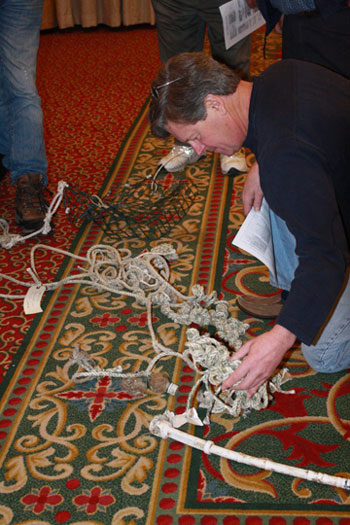Vertical Trap Line Outlook Changes
by Fishermen’s Voice Staff

Lobster Fishermen examined fishing gear removed from whales in an effort to determine what the gear was, where it might have come from and how a whale could have become entangled in it. Totes of rope and gear removed from whales since 1999 were brought to the Forum from Woods Hole Oceanographic Institute. Fishermen's Voice Photo
The Maine Lobstermen’s Association announced the preliminary results of their independently-funded whale entanglement research at the Maine Fishermen’s Forum March 1. MLA Executive Director Patrice McCarron said that while it is very early to be drawing conclusions from the data there are hopeful signs that lobster trap lines are a lesser cause of whale entanglement than previous accusations implied.
The announcement was made at a Forum session on whale entanglement sponsored by the MLA. The session was part of an effort to involve fishermen in analyzing gear that has been removed from entangled whales. Gear includes various ropes, connector parts, nets, etc. This “reverse engineering” part of the session was designed to trace back through whale entanglement events documented by National Marine Fisheries Service (NMFS) in an effort to better understand how, where and why whales were being entangled in gear.
Fishermen who work with lobster gear every day and find miscellaneous stray gear in the water or on their traps while hauling are better able to identify combinations of ropes, links, knots, nets etc., that had found attached to whales. Volunteers and scientists who have disentangled whales in some cases assumed the lines found on whales were lobster trap lines.
Fishermen who examined the gear at the Forum said some of the sections of gear were not from lobster traps. Some were pieces of fixed gear like gill nets, Canadian-style lobster trap gear and oddly-rigged sections that could not be identified with any particular fishery.
Fishermen noted that a lot of gear fragments are found in the water. Gear examined by fishermen at the Forum came from pieces collected at Woods Hole. Some of the gear was taken from whales as far back as 1999. The Large Whale Take Reduction Team began in 1996.
In February, a group of 10 fishermen from this project went to the Woods Hole Oceanographic Institute (WHOI) to examine similar sections of fishing gear and offer marine biologists from the federal whale entanglement project suggestions on what the gear collected from whales was likely used for, how to identify the fisheries, distinguish rope and parts that were scraps of gear or not fishing gear at all, and how whales might have gotten entangled in it.
Fishermen Kristan Porter of Jonesport and Elliot Thomas of Stonington said the Woods Hole scientists thought the information would make it possible for them to better identify gear collected in the future. The fishermen also said it was an opportunity to explain how they fish.
The observations of gear and rigging is also expected to be useful in making changes to gear that will make it more whale safe.
The Forum program was divided into two parts. The first part was reverse engineering, that is, examining the different sections of gear, considering where it was found, watching video of the particular gear entanglement, considering the death of the whale if it died, having fishermen analyze the gear and discuss how the whale may have gotten entangled in the first place.
This tracing back through the available facts is intended to facilitate the devising of fishing gear systems that are more whale-safe. The reverse engineering workshop enabled fishermen to better understand what scientists were doing in their offices and helped the scientists better understand what fishermen are doing on the water.
The second part of the session was about the risk assessment model the MLA has developed over the last three years. McCarron said the fishermen learned from the sinking rope issue that they didn’t have a way to talk to scientists about their fishing gear and its interactions with whales.
Three years ago the decision was made to contract with scientists to have them build a highly specialized computer model that could analyze a wide range of fishing data. The MLA initiated the project, organized a team to carry it out, and raised the money to make it happen. The model built by WHOI marine scientists processes a wider range of fisheries data than was being processed by the NMFS computer model.
The MLA’s computer model measures the risks of fishing gear that is quantifiable for scientists and for management. The information brings credibility to what fishermen have to say about entanglement issues, said McCarron.
The NMFS risk model is very different in that it covers all the coast from Maine to Florida, all fixed gear in all fisheries, only sightings of the humpback and right whale, and measures lobster fishing effort with a count of vertical lines by zone.
The MLA model covers only the Gulf of Maine and only the right whale. It includes many more factors than the NMFS model such as water temperature, depth, various environmental conditions as well as whale behavior. Fishing effort considers trawl configurations, the month of the year and is done by harbors, not zones.
McCarron said, “the most rewarding thing to come out of the 3-year effort was to find that what the fishermen were saying all along was right.” While she emphasized that the results are preliminary she said it was “very, very encouraging” that the model results aligned with what the fishermen were saying.
The model predicts where change would be more effective compared to other options. The assessment of various risk factors will help managers to know better which to address.
